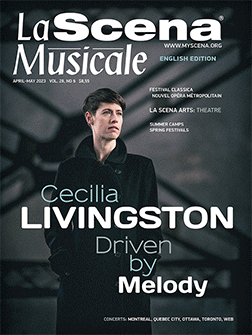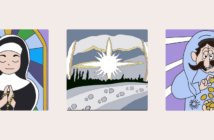
This page is also available in / Cette page est également disponible en:
Français (French)
After the futurist dystopia Seeker (winner of the Prix Michel-Tremblay for Best New Play 2022), playwright Marie-Claude Verdier turns to the second half of the 19th century and proposes an encounter with the most unconventional king, Louis II of Bavaria (1845-1886)—a pacifist and great lover of the arts. Director Claude Poissant brings a modern documentary approach to the setting of the romantic drama that the author has perfected over the course of many years.
“I became fond of this most unlikely king when I was playing Gabriel Knight 2, a video game created by Jane Jensen, in which the figure of King Ludwig II was featured,” says Verdier. Later, during a linguistic internship in Germany, the would-be author studied not far from Herrenchiemsee Castle—the last castle that the king had built, on the model of Versailles. But because of a lack of resources, the building was not completed.
Protest architecture
About 20 ceremonial reception rooms were finished, but as soon as you leave them, you notice the bare plaster and you understand that the castle is a showcase that Ludwig II actually built to stage his dream of absolute monarchy, Verdier notes. In his very own way, the constitutional king challenged the treaty of German unification imposed by Bismarck at Versailles in 1871, in the wake of one of the first modern wars. His own brother Otto went and came back with a post-traumatic shock from which he would never recover.
“It is believed that Ludwig II had intended to build a Hall of Mirrors that Bismarck and the Prussians would not have soiled,” explains the author. Indeed, Ludwig II instructed his architects to replicate the initial layout of Versailles, thanks to original engravings of the period. The Herrenchiemsee is a provocation to the German Reich and its emperor—the architectural statement of a man who rejects political manipulation. In the production, set designer Odile Gamache reimagines a two-D set to frame this text of Wagnerian amplitude.
“Châteaux du ciel addresses some specific historic events, but I’m concerned with a mind, its humanitarian and political intentions—I’m telling a story,” says the playwright, who prefers to evoke a biography of the heart rather than facts. Over the course of 32 scenes and as many locations, she describes a sickly shy man, disabled by a nasty fall from a horse, suffering from terrible migraines that drive him into hiding from the light—and living at night. He identifies himself with Parsifal, the knight of the pure, while his brother is more of a match with Gauvin, the secular knight, and Castles of Heaven is oriented in this direction.
Dazzled by Wagner
Nurtured by his reading of epics and legends, the young Louis discovered Richard Wagner’s The Artwork of the Future at the age of 13. Later, as a teenager, he attended a performance of the romantic opera Lohengrin. The young man was mesmerized by the overwhelming experience of the opera, the materialization of his childhood dreams. So when he acceded to the crown, his first action was to summon Wagner, not sparing any effort to clear the composer’s numerous debts and to provide him with an annuity.
A disillusioned anarchist, Wagner transposed his eagerness to overthrow institutions to his music. He was determined to abolish the rules he had been forced to apply to his life and art. Wagner intended to spread rebellion in the hearts of the people through his opera. Thievery, fratricide, incest: his heroes break the most ancient laws. Nevertheless, his final goal of pureness subjugated Ludwig II, who was ashamed of his gay identity and obsessed by chastity. Is he the first queer king? In 2023, the question stands, believes Claude Poissant, who gave a documentary approach to his direction.
After being exiled, Wagner returned to Bayreuth where Ludwig II commissioned the construction of a theatre to perform his works. The first Richard Wagner Festival featured The Ring, the cycle of four operas that Wagner had devoted 30 years to compose, and it was a triumph (1876). The Total Work of Art, which combines poetry, dance, music and architecture, was created. Inspired by the music of the master and his abrupt pauses, Philippe Brault composed the soundtrack for the show.
Ludwig II’s enigma
The sovereign is loved by his subjects. For him, all men are brothers. “He is a leader who stands for more than violence or economics; he strives for values that are very little put to the fore and his passion for beauty impressed me,” says Verdier, who mentions his commitment to educating young girls. The monumental worksite at Neuschwanstein Castle (which inspired Disney‘s castle) also led to the creation of a form of social insurance that was revolutionary at the time.
Ludwig II was more than a dreamer. A forward thinker, he was keen on modern technology and scientific research; in Munich, he founded the Polytechnic University (1868). He was also enthusiastic about innovations such as the telephone, running water and heating, and installed the first public baths in the park of Nymphenburg Palace and an electric light system. His fascination with new technologies greatly contributed to the modern industrialization of Bavaria.
“I have made this beautiful story my own to talk about our times,” Marie-Claude Verdier explains, reporting a comment which was picked up during a discussion about building a shelter for abused women. It can’t be beautiful, this board member said. “I would never presume to define what beauty is, but denying it to individuals is a revealing abuse of our very society.”
A reclusive king—a romantic hero in a situation that was far from romantic—Ludwig II wished to remain an enigma to himself and to others.
Châteaux du ciel opens up the world of Ludwig II of Bavaria, Wagner’s protector, and his insatiable esthetic quest. At Denise-Pelletier, until April 15.
This page is also available in / Cette page est également disponible en:
Français (French)















